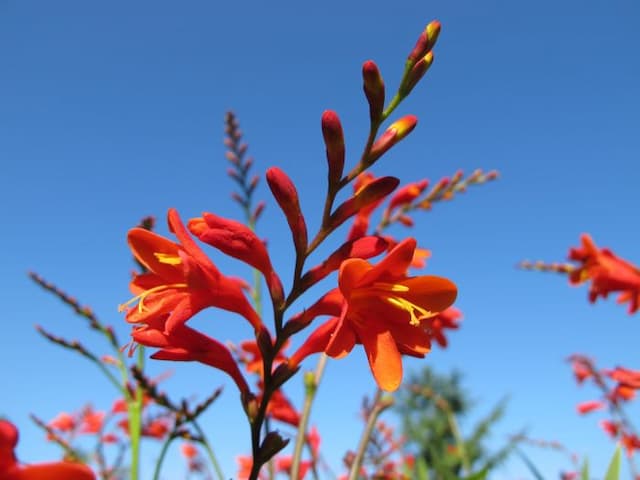Iris Iris 'Pale Shades' (IB)

ABOUT
The Iris 'Pale Shades' features a beautiful array of pastel-colored flowers that are particularly known for their delicate, light hues. The blooms are typically a soft mix of colors that can include pale blue, lavender, pink, and sometimes a creamy yellow or white. The ruffled petals gracefully unfold from the bud, giving the impression of a gentle and refined display. The iris flowers have a unique structure with three upright petals, known as standards, and three downward-curving petals called falls. These hanging petals often showcase a lovely contrast with their lighter hues adorned by bold, striking veining or markings that lend an intricate appeal to the overall appearance. The foliage of the Iris 'Pale Shades' consists of long, sword-like leaves that are deep green in color, forming an attractive, vertical accent to the garden even when the plant is not in flower. These leaves grow in dense clumps that emerge from thick, underground stems known as rhizomes. The plant has a sturdy and upright habit, with the flowers perched atop the sturdy stems that rise elegantly above the foliage. With its captivating colors and stately bearing, Iris 'Pale Shades' is a popular choice for adding soft color and a touch of elegance to garden borders, beds, and waterside plantings.
About this plant
 Names
NamesFamily
Iridaceae
Synonyms
Bearded Iris, German Iris
Common names
Iris 'Pale Shades'
 Toxicity
ToxicityTo humans
The Intermediate Bearded Iris, commonly known as the Bearded Iris, may have parts that are considered toxic if ingested. The rhizomes are especially known to contain irritants that can cause stomach upset and other symptoms such as nausea, vomiting, abdominal pain, and diarrhea if ingested. Handling the plant may also cause skin irritation in sensitive individuals.
To pets
The Intermediate Bearded Iris, or Bearded Iris, is known to be toxic to pets if ingested. Similar to its effects on humans, the rhizomes contain compounds that can cause gastrointestinal upset in animals, leading to symptoms like vomiting, drooling, lethargy, and diarrhea. In severe cases, ingestion may lead to more serious issues such as depression of the central nervous system. It's advised to keep pets away from the plant to prevent accidental ingestion.
 Characteristics
CharacteristicsLife cycle
Perennials
Foliage type
Deciduous
Color of leaves
Green
Flower color
Varies
Height
2 feet (60 cm)
Spread
1 foot (30 cm)
Plant type
Bulb
Hardiness zones
3
Native area
Temperate Northern Hemisphere
Benefits
 General Benefits
General Benefits- Decorative Appeal: Iris 'Pale Shades' adds elegance to gardens with its delicate pale-colored flowers.
- Easy to Grow: Requires minimal maintenance and is hardy in a variety of climate zones.
- Drought Tolerance: Once established, it can withstand periods of low water availability.
- Cold Resistance: Able to survive and bloom even after cold winters.
- Attracts Pollinators: Bees, butterflies, and other pollinators are drawn to its flowers, contributing to the health of the ecosystem.
- Cut Flowers: The blooms are long-lasting when cut and are excellent for floral arrangements.
- Breeding Potential: Can be used by gardeners and hybridizers to create new varieties of irises.
- Seasonal Interest: Provides a burst of color in the springtime, offering visual interest when many other plants are not yet in bloom.
 Medical Properties
Medical PropertiesThis plant is not used for medical purposes.
 Air-purifying Qualities
Air-purifying QualitiesThis plant is not specifically known for air purifying qualities.
 Other Uses
Other Uses- Dye Extraction: Iris petals can be used to create natural dyes for fabrics, papers, and other materials, offering a range of colors from pale yellows to rich purples depending on the part of the plant used.
- Perfume Industry: The plant's roots, known as orris root, are commonly used in perfumery as a fixative to enhance the longevity of a fragrance on the skin.
- Artistic Inspiration: Irises often serve as a muse for artists and can be found depicted in various forms of artwork, including paintings, sculptures, and textile designs.
- Culinary Garnish: Edible varieties of Iris can have their petals used as a colorful garnish for salads and desserts for an elegant presentation.
- Botanical Studies: This Iris can be used in botanical studies and garden demonstrations to show the diversification and breeding of Iris plants.
- Photographic Subjects: Because of their distinct appearance, Irises are popular subjects for photographers specializing in botanical and nature photography.
- Water Purification: When planted in a water garden, some Iris species can help filter and clean the water by absorbing toxins through their roots.
- Floral Design: Irises are frequently used in floral arrangements and bouquets for events like weddings and anniversaries due to their striking appearance and symbolism of wisdom and hope.
- Eco-Friendly Crafting: Dried Iris flowers and seed pods can be used in eco-friendly craft projects, such as creating natural jewelry or decorations.
- Fragrance for Linens: Dried Iris petals and orris root can be used to create sachets that provide a subtle fragrance to linens and clothing when placed in drawers or closets.
Interesting Facts
 Feng Shui
Feng ShuiThe Iris is not used in Feng Shui practice.
 Zodiac Sign Compitability
Zodiac Sign CompitabilityThe Iris is not used in astrology practice.
 Plant Symbolism
Plant Symbolism- Royalty: Due to its regal appearance and history, the Iris often symbolizes royalty and regal bearing.
- Wisdom: The Iris is associated with wisdom and valued for its capacity to convey a sense of intelligence.
- Hope: Irises can represent hope, delivering a message of positive expectation and anticipation.
- Trust: With its firm standing and strong structure, the Iris can be a symbol of trust.
- Faith: The flower signifies faith, embodying belief in various cultures and contexts.
- Valor: In some traditions, the Iris is linked with valor and bravery.
- Purity: The pale shades of the Iris can indicate purity and innocence, as lighter hues are often associated with these qualities.
 Water
WaterThe Iris 'Pale Shades', commonly known as a type of Intermediate Bearded Iris, requires watering that keeps the soil consistently moist, but not waterlogged. During the growing season, particularly in the absence of rainfall, water the plant about once or twice a week with approximately 1 inch of water. It's essential to reduce watering after the blooming period and as the plant enters dormancy in late summer. In drier climates or during particularly hot weeks, you may need to increase the frequency of watering but always ensure the soil has good drainage to prevent root rot.
 Light
LightIntermediate Bearded Iris thrives in full sun conditions. For best flowering, plant it in a location where it can receive at least six hours of direct sunlight daily. Too much shade can result in poor bloom performance. A position in the garden that offers morning sunlight and some afternoon shade can be beneficial in extremely hot climates, but generally, a sunny spot is ideal for this iris variety.
 Temperature
TemperatureIntermediate Bearded Iris prefers temperate climates and can generally tolerate temperatures ranging from below freezing during their dormant winter period to summer highs around 90 degrees Fahrenheit. They can survive minimum winter temperatures of around -20 degrees Fahrenheit, but the ideal growing temperature range during the active growth season is between 55 and 75 degrees Fahrenheit.
 Pruning
PruningPruning Intermediate Bearded Iris is essential for maintaining plant health and encouraging blooms. Deadheading, the process of removing spent flowers, should be done consistently throughout the blooming season to promote further flowering. After blooming is finished, the foliage should be left intact to allow the plant to gather energy for the next season. In late fall, cut back foliage to a few inches to prevent overwintering pests and diseases. The best time for general pruning and removing old or damaged leaves is early spring before new growth starts.
 Cleaning
CleaningAs needed
 Soil
SoilThe best soil mix for an Intermediate Bearded Iris like 'Pale Shades' should be well-draining, loose, and moderately fertile. A mix of garden loam, compost, and coarse sand can work well. The ideal pH for irises is slightly acidic to neutral, ranging from 6.5 to 7.0.
 Repotting
RepottingIntermediate Bearded Irises, such as 'Pale Shades', typically do not need to be repotted often if planted outdoors. Instead, they should be divided every 3 to 5 years to prevent overcrowding and to rejuvenate the clumps.
 Humidity & Misting
Humidity & MistingIntermediate Bearded Irises, including 'Pale Shades', are adaptable to a wide range of humidity levels and thrive best in outdoor conditions where the humidity mirrors the natural environment. They do not require high humidity.
 Suitable locations
Suitable locationsIndoor
Place in bright light and ensure good air circulation.
Outdoor
Full sun, well-draining soil, and space rhizomes apart.
Hardiness zone
3-9 USDA
 Life cycle
Life cycleIris 'Pale Shades' (Intermediate Bearded Iris) typically begins its life cycle with seed germination, which occurs when the seeds experience a period of cold dormancy followed by warmer temperatures. The seedlings emerge and establish a root system, developing into vegetative plants with characteristic long, sword-like leaves. As the irises mature, they form rhizomes, which are underground stems from which the foliage and flowers arise. The Intermediate Bearded Iris typically blooms in late spring to early summer, producing delicate flowers in a range of pale hues that may include blues, lavenders, and whites. After flowering, the plant enters a period of dormancy in the hotter summer months. The rhizomes can be divided every few years to propagate the plant and maintain vigor.
 Propogation
PropogationPropogation time
Late Summer - Fall
The Iris 'Pale Shades', commonly known as the Intermediate Bearded Iris, is often propagated through division, which is typically done after flowering in late summer. To propagate the Iris by division, the clumps should be carefully dug up and the rhizomes, which are the horizontal stems from which the plants grow, need to be separated. Each section should have at least one fan of leaves and a portion of the rhizome. The leaves should be trimmed to about one-third of their original height to reduce transpiration. The divided rhizomes can then be replanted into well-draining soil, spaced about 12 to 18 inches (30 to 45 centimeters) apart to provide enough room for growth. The rhizomes should be planted so that the tops are slightly exposed to the sun, as burying them too deeply can inhibit blooming or increase the potential for rot.








![Montbretia [Little Redhead]](/_next/image?url=https%3A%2F%2Fplants-admin.emdemapps.com%2Fimages%2Fplants%2F%2Fimages%2F604b5635373f8.png&w=640&q=75)
